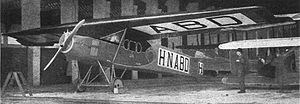Fokker F.II Video - Picture

|
|
Fokker F.II
F.II

Picture - the third F.II
Role: Airliner
Manufacturer: Fokker
Designed by: Reinhold Platz
First flight: October 1919
Retired: 1934
Status: retired
Primary users: KLM
Deutsche Aero Lloyd
Number built: c.23
The Fokker F.II was the first of a long series of commercial aircraft from the Fokker Aircraft Company, flying in 1919. In a biplane age, it presented a distinct clean, high wing monoplane style that sold successfully across Europe and North America during the development of commercial passenger-carrying aviation.
Design and development
The Fokker F.II was a single engined high-wing cantilever monoplane with a design lineage that went back to designer Reinhold Platz's Dr.I triplane, via the biplane D.VII and monoplane D.VIII fighters and his unflown F.I civil design. The Dr.I was the first aircraft to use the thick high lift/drag airfoils that enabled high climb rates and also allowed internal wing bracing. Hence the triplane wing needed no external wire bracing and its monoplane successors, apart from attachments to the fuselage were simple cantilever structures.
The F.II had other characteristic early-Fokker design features: a wing constructed of wood, fully skinned in plywood, with ailerons extending beyond the wingtips and a deep sided square section fuselage of welded steel tube covered in fabric which provided enough directional stability that no vertical fin was fitted. The F.II had a fixed undercarriage, the main units of which were joined by a cross-axle.
There was enclosed accommodation for four passengers; a fifth could travel alongside the pilot in his unenclosed cockpit, in a seat originally intended for a mechanic or navigator.
The prototype F.II, known by the company designation V.45, was constructed at the Fokker factory in Schwerin, Germany, and made its first flight there in October 1919. When Anthony Fokker decided to relocate the firm to the Netherlands, the V.45 was illegally flown across the border on 20 March 1920. Even after this, perhaps another three examples were built at Schwerin before production shifted to Veere. The prototype was powered by a 138 kW (185 hp) BMW IIIa. This proved to have cooling problems, and after an experiment with a 133 kW (178 hp) Mercedes motor, KLM who took this machine as one of two they ordered fitted it with a 179 kW (240 hp) Armstrong Siddeley Puma. Their second F.II was similarly re-engined.
In Germany, however, the technical manager of Deutsche Aero Lloyd, Karl Grulich arranged to build the type under licence for the airline, making a few modifications of his own to the design. These included strengthened landing gear, a redesigned cockpit, and redesigned trapezoidal cabin windows. At least 20, the great majority of F.IIs, were assembled by Deutsche Aero Lloyd at Staaken, Berlin. They built the fuselages there, but the wings were built by Albatros and were then supplied to the airline for final assembly. These rather heavier aircraft were powered by 172 kW (230 hp) BMW IV (and later 239 kW/320 hp BMW Va) motors.
Operational history
KLM operated two F.IIs between 1920 and 1927, which were then sold to SABENA who used them on their Brussels-Antwerp route. The machines that Fokker had built in Germany were bought by Deutsche Luftreederei and registered in the Free City of Danzig. Deutsche Aero Lloyd's aircraft were used right up until the time the airline was absorbed by Deutsche Lufthansa in 1926, at which point ten machines remained. These were put to use on regional routes linking Cologne with Aachen, Essen, Krefeld, and Mx¼lheim until 1934.
Operators
KLM
SABENA
Deutsche Aero Lloyd/Deutsche Lufthansa
Deutsche Luftreederei
Specifications (Puma powered)
Data from de Leeuw p.13
General characteristics
Crew: One pilot
Capacity: 5 passengers
Length: 11.65 m (38 ft 3 in)
Wingspan: 16.10 m (52 ft 10 in)
Height: 3.66 m (12 ft 0 in)
Wing area: 38.2 m² (411 ft²)
Empty weight: 1,200 kg (2,650 lb)
Gross weight: 1,900 kg (4,190 lb)
Powerplant: 1 x— Armstrong Siddeley Puma, 180 kW (240 hp) each
Performance
Maximum speed: 150 km/h (93 mph)
Cruising speed: 120 km/h (75 mph)
Range: 1,200 km (750 miles)
Anderson, J.D. A History of Aerodynamics (1997). Cambridge University Press. ISBN 1521 66955 3
de Leeuw, R. Fokker Commercial Aircraft (1994). Fokker Publications
Taylor, Michael J. H. (1989). Jane's Encyclopedia of Aviation. London: Studio Editions. pp. 405.
World Aircraft Information Files. London: Bright Star Publishing. pp. File 894 Sheet 36.
"A Fokker Raid on London". Flight: 1064-66. 7 October 1920. http://www.flightglobal.com/PDFArchive/View/1920/1920%20-%201062.html. Retrieved 2008-03-26.
Fokker F.II Pictures
More aircraft.
Source: WikiPedia